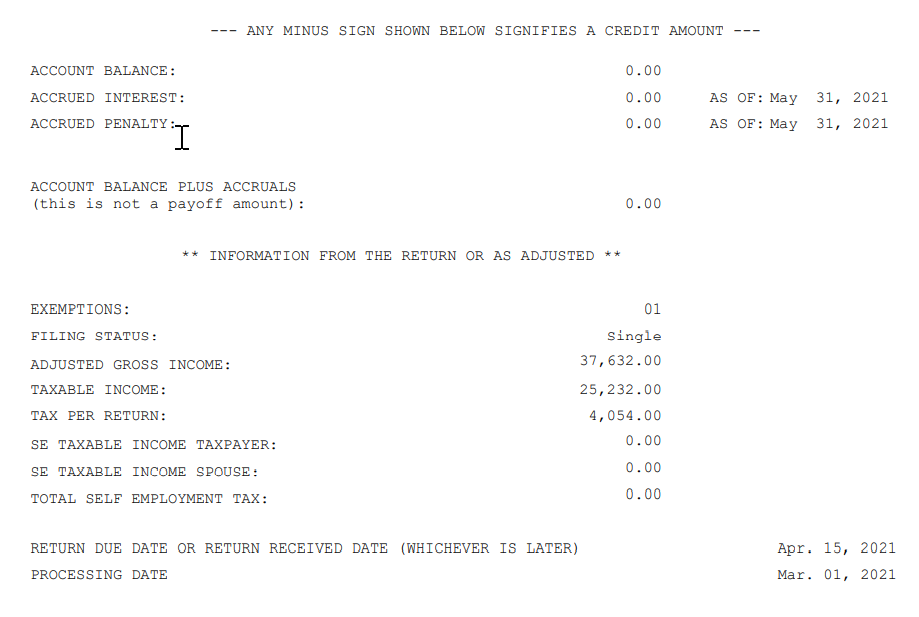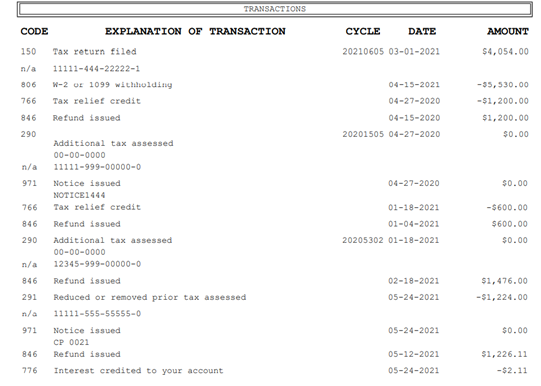How to Read My Tax Return Transcript
Many individuals may not know they can request, receive, and review their tax records via a tax transcript from the IRS at no charge. Function I explained how transcripts are often used to validate income and tax filing status for mortgage applications, student loans, social services, and small business concern loan applications and for responding to an IRS notice, filing an amended return, or obtaining a lien release. Transcripts tin can also exist useful to taxpayers when preparing and filing revenue enhancement returns by verifying estimated revenue enhancement payments, Advance Child Tax Credits, Economical Income Payments/stimulus payments, and/or an overpayment from a prior year return.
Reading and Understanding IRS Transcripts
While IRS transcripts can exist helpful, reading and understanding them can be complicated. The IRS's processing arrangement, the Integrated Data Retrieval Organisation (IDRS), uses a organisation of codes to identify a transaction the IRS is processing and to maintain a history of actions posted to a taxpayer's business relationship. These Transaction Codes (TCs) basically provide processing instructions to the IRS's organization. To make IRS transcripts convenient for the public, the IRS provides a literal description of each TC shown on a taxpayer'southward IRS transcript. Although helpful, sometimes these descriptions don't adequately explain the account transaction. Document 11734, Transaction Lawmaking Pocket Guide, is a summarized listing of TCs taken from section 8A of the IRS's Certificate 6209, ADP and IDRS Information Reference Guide, both of which may be helpful when reviewing an IRS transcript.
A Closer Look at the IRS Tape of Account Transcript
As shown in the fictitious example below, the Record of Account Transcript will summarize any balance due or overpayment on a taxpayer's account for the specified year at the top of the form. If the account reflects a rest due, the transcript provides the date to which any accrued penalty and interest were calculated. Adjacent, the transcript will show specific information from the taxpayer's return – or the corrected amounts resulting from any changes to the render caused by either a request from the taxpayer or an IRS conclusion. This is noteworthy should a taxpayer find information technology necessary to file an amended return. The correct figures must exist used every bit the starting point on Form 1040X, Amended US Individual Income Tax Return, when requesting any subsequent account adjustments – otherwise, processing problems may occur.
Figure one
The Tax Account Portion of the Record of Accounts
This section of the Record of Accounts Transcript provides details regarding the taxpayer's account activity, equally shown in Effigy two.
Figure 2

Some of the mutual TCs on the tax account portion of a transcript are:
- TC 150 – Date of filing and the amount of taxation shown on the taxpayer's render when filed – or as corrected past the IRS when processed;
- TC 196 – Interest Assessed;
- TC 276 – Failure to Pay Revenue enhancement Penalty;
- TC 291 – Abatement Prior Tax Assessment;
- TC 300 – Additional Revenue enhancement or Deficiency Assessment by Exam Division or Collection Segmentation;
- TC 420 – Test Indicator reflects that a render is under examination consideration though the return may or may not ultimately be audited;
- TC 428 – Examination or Appeals Instance Transfer;
- TC 460 – Extension of Time for Filing;
- TC 480 – Offer in Compromise Pending;
- TC 494 – Find of Deficiency;
- TC 520 – IRS Litigation Instituted;
- TC 530 – Indicates that an account is currently not collectible;
- TC 582 – Lien Indicator;
- TC 768 – Earned Income Credit;
- TC 806 – Reflects any credit the taxpayer is given for revenue enhancement withheld, as shown on the tax return and the taxpayer'southward information statements such as Forms Westward-two and 1099 fastened to the taxpayer'due south taxation return; and
- TC 846 – Represents the issuance of a taxpayer's refund if the credits and withholding exceed the corporeality of revenue enhancement due, and there are no issues with the render, the system will automatically generate a refund.
In the above example, tax credits, withholding credits, credits for interest the IRS owes to a taxpayer, and tax adjustments that reduce the amount of taxation owed, are shown every bit negative amounts on the revenue enhancement business relationship transcript. In other words, negative amounts on an IRS transcript can be considered amounts "in the taxpayer'southward favor."
Considering TCs on a taxpayer's account are substantially instructions to the IRS organisation, it is of import to notation that some TCs are input for advisory reasons not direct associated with an accounting-related dollar amount.
I hope we accept not confused you. Using the IRS's Pocket Guide should help you lot understand the transcript and provide you with the fundamental data yous are seeking.
The Tax Return Portion of the Tape of Accounts
The revenue enhancement return portion of the Tape of Accounts depicts nigh of the line entries on the taxpayer's taxation return when information technology was filed. Figure 3 provides just the income section of our fictitious example; even so, the actual Record of Accounts will depict all the sections of a taxpayer'south filed revenue enhancement return and can exist useful when the taxpayer has not maintained a copy of his or her return and needs to know what was reported to the IRS on his or her return.
Effigy 3

New Taxation Transcript Format and Utilizing a Customer File Number
In July 2021, IRS updated a webpage on IRS.gov to brainwash taxpayers regarding the new transcript format and apply of the "customer file number," which was designed to better protect taxpayer data. This new format partially masks personally identifiable information. However, financial data will remain visible to allow for revenue enhancement return preparation, tax representation, or income verification. These changes apply to transcripts for both private and business taxpayers.
Here's what is visible on the new taxation transcript format:
- Terminal four digits of any Social Security number on the transcript: 30-20-1234;
- Last four digits of any Employer Identification Number on the transcript: XX-XXX1234;
- Last 4 digits of whatsoever business relationship or telephone number;
- Outset four characters of first proper name and first four characters of the terminal name for whatever private (outset three characters if the name has just iv letters);
- First four characters of any proper noun on the concern proper noun line (first 3 characters if the name has only four letters);
- Offset half dozen characters of the street address, including spaces; and
- All money amounts, including wage and income, rest due, interest, and penalties.
For security reasons, the IRS no longer offers fax service for most transcript types to both taxpayers and tertiary parties and has stopped its third-party mailing service via Forms 4506, 4506-T, and 4506T-EZ.
Lenders and others who use the Forms 4506 serial to obtain transcripts for income verification purposes should consider other options such as participating in the Income Verification Express Service or having the customer provide the transcript.
Only private taxpayers may use Get Transcript Online or Get Transcript by Mail. Because the full Taxpayer Identification Number is no longer visible, the IRS created an entry for a Customer File Number. The Customer File Number is a ten-digit number assigned by the third-party, for example, a loan number that can be manually entered when the taxpayer completes his or her Go Transcript Online or Go Transcript past Mail request. This Customer File Number will then display on the transcript when information technology is downloaded or mailed to the taxpayer. The transcript'south Client File Number serves equally a tracking number that enables a lender or other third political party to match the transcript to the taxpayer making the transcript request.
Conclusion
Taxpayers needing taxation return, tax account, or data render data may quickly detect what they need through the IRS's Get Transcript Online portal or their online account. I proceed to urge the IRS to aggrandize the Online Business relationship functionality and increase its availability to practitioners and businesses. The current functionalities provide many basic and helpful information, and I look forrad to continued expansion of functionality. Transcripts are free and provide a wealth of information. I encourage taxpayers to explore this option. If an IRS transcript tin can run across a taxpayer's needs, it may be preferable to trying to contact the IRS or other more time-consuming methods of requesting tax business relationship information.
Read the past NTA Blogs
The views expressed in this weblog are solely those of the National Taxpayer Advocate. The National Taxpayer Abet presents an contained taxpayer perspective that does not necessarily reflect the position of the IRS, the Treasury Department, or the Part of Management and Budget.
Subscribe to the NTA Blog
Source: https://www.taxpayeradvocate.irs.gov/news/nta-blog-transcripts-pt2/
0 Response to "How to Read My Tax Return Transcript"
Post a Comment